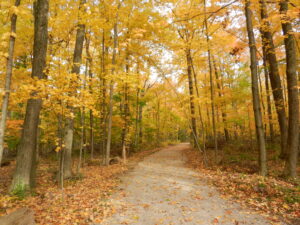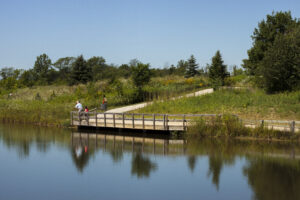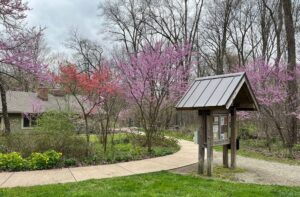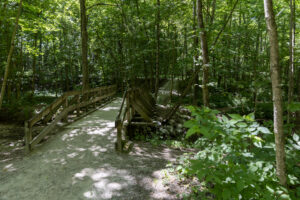By Casey Smith, Naturalist

Whether you call them monkey brains, horse apples, mock orange, or something else entirely, hedge apples are everywhere in the fall. Someone lines the guardrail on SR 315 just opposite Bunty Station Road with them every year, and for some reason it makes me so happy. These weird bright green spheres, roughly the size of a softball, emerge on female Osage orange trees in September – October. The trees are dioecious, meaning male and female flowers are found on separate trees, and female trees produce the fruit. When cut open, the fruit and stems both secrete a latex goo, much like that found in milkweed plants. This makes the fruit toxic and largely inedible. Though the seeds can be eaten, the work it takes to get them is not worth the effort. Even squirrels can’t eat too much of the fruit without feeling the effects of the toxins. Typically, trees that bear fruit rely on animals to eat the fruit and later expel the seeds in another location to help disperse those seeds. So why would a tree living in Ohio produce a fruit that no animal wants to eat? Let’s look at the history of the tree to figure out this hedge apple head scratcher.
The tree itself is covered in sharp spines. Much like the honey locust, this suggests that the tree needed protection from large herbivores, such as the megafauna found during the Ice Age. This means that the hedge apples were adapted to be dispersed by large, now extinct mammals. Over 12,000 years ago, a giant ground sloth roaming what is now Texas could have eaten its fair share of the fruit and not felt the effects of the toxic latex goo. The sharp spines would have helped protect the actual tree. The Osage orange trees we see today are out of their historic range, and just haven’t had time to adapt to the loss of Ice Age megafauna for seed distribution. Evolution takes a long time, apparently.
In the 1800s Osage orange trees were found in just 3 southwestern states. They spread from there because when planted closely together and pruned correctly they would create a fence row that was “bull strong, hog tight, and horse high”, meaning a bull wouldn’t push through it because of its thorns, a hog couldn’t get between the tight growth, and a horse couldn’t jump over it. This was before the invention of barbed wire. These trees aren’t picky when it comes to growing conditions, they tolerate poor soil, have no insect or disease problems, can withstand extreme weather conditions, and can now be found in 39 states. The wood is strong and dense with a beautiful orange color. The actual name Osage orange comes from the southwestern Osage tribe of Native Americans who used the strong, flexible wood for making bows. It was once said that the price of a good Osage orange bow was a horse and a blanket.
Today the wood is made into beautiful pieces of furniture and art. Hedge apples are often used as decoration, thrown around by kids, and run over on the street. Their seed dispersal is now reliant on floating downstream or rolling downhill. Some people place hedge apples around their home’s foundations, believing they have insect repellent properties, though there is no real evidence to support this. But I still have a few on my front porch, just in case.
Check out these links for more cool information on Osage orange trees
www.nps.gov/articles/Osage-apple-orange.htm
www.americanforests.org/magazine/article/trees-that-miss-the-mammoths/






